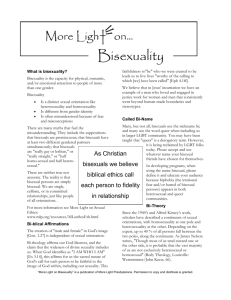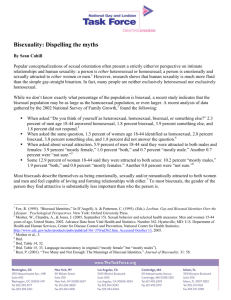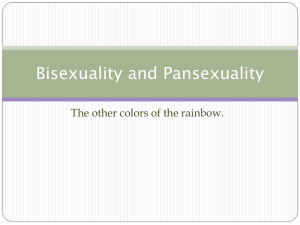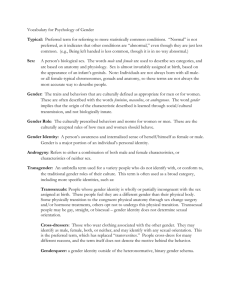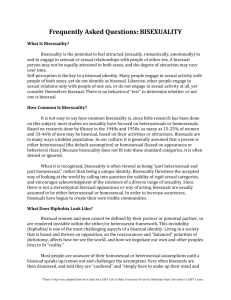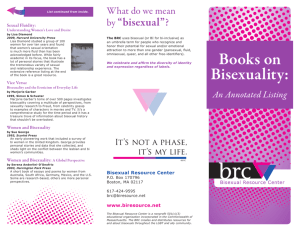Bisexuality 101 - Unitarian Universalist Association
advertisement
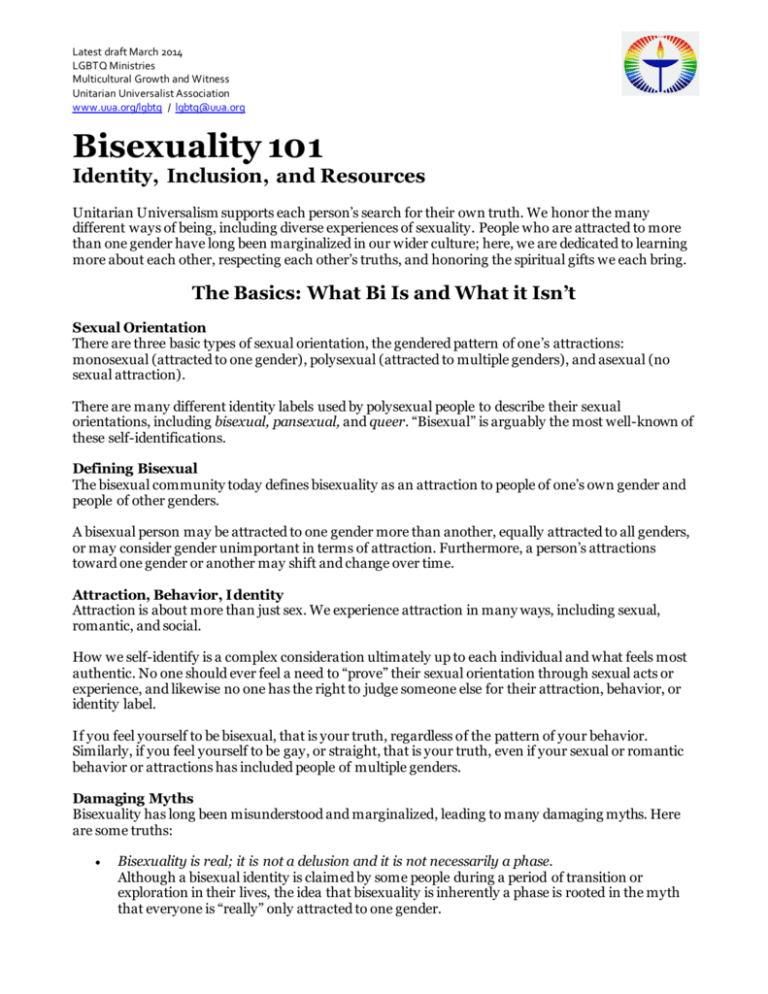
Latest draft March 2014 LGBTQ Ministries Multicultural Growth and Witness Unitarian Universalist Association www.uua.org/lgbtq / lgbtq@uua.org Bisexuality 101 Identity, Inclusion, and Resources Unitarian Universalism supports each person’s search for their own truth. We honor the many different ways of being, including diverse experiences of sexuality. People who are attracted to more than one gender have long been marginalized in our wider culture; here, we are dedicated to learning more about each other, respecting each other’s truths, and honoring the spiritual gifts we each bring. The Basics: What Bi Is and What it Isn’t Sexual Orientation There are three basic types of sexual orientation, the gendered pattern of one’s attractions: monosexual (attracted to one gender), polysexual (attracted to multiple genders), and asexual (no sexual attraction). There are many different identity labels used by polysexual people to describe their sexual orientations, including bisexual, pansexual, and queer. “Bisexual” is arguably the most well-known of these self-identifications. Defining Bisexual The bisexual community today defines bisexuality as an attraction to people of one’s own gender and people of other genders. A bisexual person may be attracted to one gender more than another, equally attracted to all genders, or may consider gender unimportant in terms of attraction. Furthermore, a person’s attractions toward one gender or another may shift and change over time. Attraction, Behavior, Identity Attraction is about more than just sex. We experience attraction in many ways, including sexual, romantic, and social. How we self-identify is a complex consideration ultimately up to each individual and what feels most authentic. No one should ever feel a need to “prove” their sexual orientation through sexual acts or experience, and likewise no one has the right to judge someone else for their attraction, behavior, or identity label. If you feel yourself to be bisexual, that is your truth, regardless of the pattern of your behavior. Similarly, if you feel yourself to be gay, or straight, that is your truth, even if your sexual or romantic behavior or attractions has included people of multiple genders. Damaging Myths Bisexuality has long been misunderstood and marginalized, leading to many damaging myths. Here are some truths: Bisexuality is real; it is not a delusion and it is not necessarily a phase. Although a bisexual identity is claimed by some people during a period of transition or exploration in their lives, the idea that bisexuality is inherently a phase is rooted in the myth that everyone is “really” only attracted to one gender. Latest draft March 2014 LGBTQ Ministries Multicultural Growth and Witness Unitarian Universalist Association www.uua.org/lgbtq / lgbtq@uua.org Bisexual people are just as likely to be monogamous as anyone else. Being attracted to more than one gender does not mean that a person has to be in a relationship with people of more than one gender simultaneously. Similarly, bisexual people are not inherently more promiscuous than other people. Being monogamous does not negate a person’s bisexuality. Being in a monogamous relationship does not change a person’s sexual orientation or identity. 10 Ways to be More Welcoming & Inclusive of Bisexual People 1. Always respect a person’s identity and the language they use to talk about themselves. 2. Learn more about bisexual identity on your own. You might start by reading at least two articles or books or watching video clips that increase your understanding of bisexual identity. 3. Assume that bisexual people are present in your congregation and avoid assumptions based on your perceptions of the gender of the people someone partners with—open yourself to the possibility that any person, in any relationship or in no relationship, might identify as bisexual. 4. Work to challenge myths and negative stereotypes about bisexual people in yourself and in people around you. Be a bisexual ally. 5. Use language that is inclusive of bisexuality. For example, the term “gay marriage” sends the message that all people in same-sex relationships identify as gay, which isn’t true. Similarly, “LGBTQ” sometimes gets used in a way that assumes that all LGBTQ people are in same-sex relationships, invisibilizing bisexual, transgender, and queer people in different-gender relationships. 6. Expand the ways that sexual orientation is understood and discussed in your congregation beyond the idea that sexual orientation is a born-in, static trait. Although many people believe themselves to have been born lesbian, gay, bisexual, queer, or straight, others experience sexuality as fluid and changing throughout their lifetime. Honor this diversity of experience through the ways you talk and teach about sexual orientation. 7. Do continuing education for your congregation at large on bisexual and queer issues. Consider Sunday services, panel discussions, small group ministry topics, and hosting community events. See below for resource suggestions. 8. Talk to children about sexuality in healthy ways. Provide age-appropriate education that acknowledges the diversity of sexual orientation, explicitly talks about bisexuality, and helps children and youth understand how to build healthy relationships regardless of the gender of the people they are attracted to. 9. Ensure that clergy, pastoral care providers, lay leaders, staff, religious education volunteers, and other congregational leaders are familiar with the specific concerns of bisexual people and are prepared to minister to bisexual people of all ages. 10. Deepen relationships and partnerships between your congregation and LGBTQ community organizations and social justice groups. Ensure that your LGBTQ justice ministry isn’t limited to working only for justice and rights for people in same-sex relationships. Find out more about the needs of bisexual and other polysexual people and take action. Latest draft March 2014 LGBTQ Ministries Multicultural Growth and Witness Unitarian Universalist Association www.uua.org/lgbtq / lgbtq@uua.org Further Resources RELIGIOUS RESOURCES Bisexuality Curriculum from Interweave: www.interweaveuu.org Bisexuality: Making the Invisible Visible in Faith Communities, a guidebook from the Religious Institute: www.religiousinstitute.org/bisexuality Is Everyone Included?: Bisexuals, from the Religious Institute: www.religiousinstitute.org/acting-out-loud/bisexuals BISEXUAL RESOURCE PAGES Author Robyn Ochs’s bisexual resources: http://robynochs.com/bisexual Bisexual Resource Center: www.biresource.org BiNet USA: www.binetusa.org FILMS & VIDEO CLIPS Bi-sex’u-al: www.ucc.org/lgbt/resources.html Crossing the Line: http://deveauxbabin.com/index.php?pagename=virgins “It Gets Better” video from the American Institute of Bisexuality: www.youtube.com/watch?v=aGXCC9VCMF4#t=12 Bisexuality: Myths vs Facts by Scarlet Saint: www.youtube.com/watch?v=j63sq5qTIok Bisexual Men: Myths and Questions, by F**k Y eah Bi Guys: www.youtube.com/watch?v=IZFZJSMaVQg HuffPo Live segment on 20 Bisexual Celebrities: www.youtube.com/watch?v=jycK3P-ylEY BOOKS Bi Any Other Name: Bisexual People Speak Out, edited by Loraine Hutchins and Lani Kaahumanu (1991) Bisexuality in the United States, edited by Paula C. Rodriguez Rust (2000) Blessed Bi Spirit: Bisexual People of Faith, by Debra R. Kolodny (2000) Getting Bi: Voices of Bisexuals Around the World, Second Edition, by Robyn Ochs (2009) Sexuality, Religion and the Sacred: Bisexual, Pansexual and Polysexual Perspectives, edited by Loraine Hutchins and H. Sharif Williams (2011)
